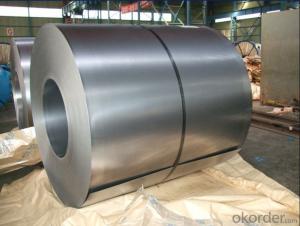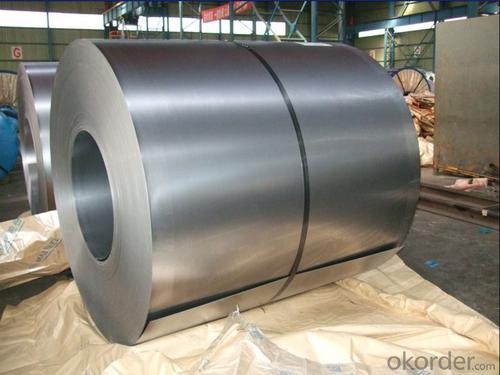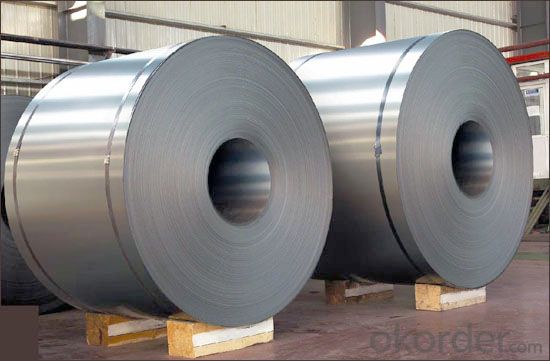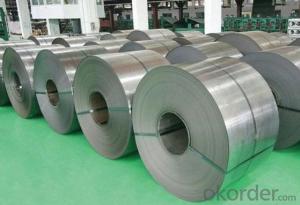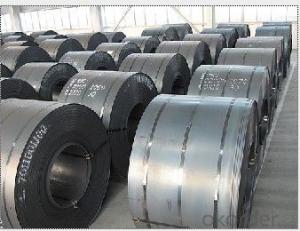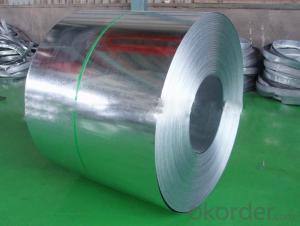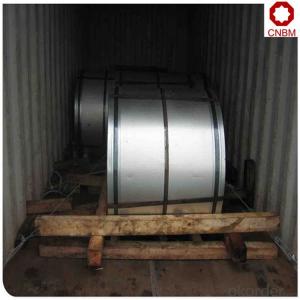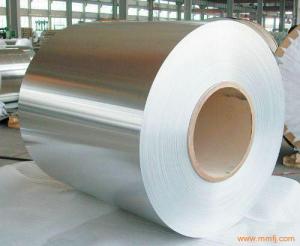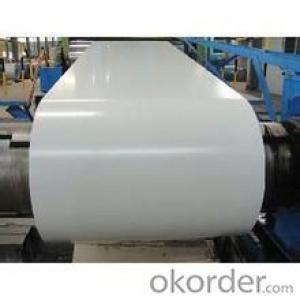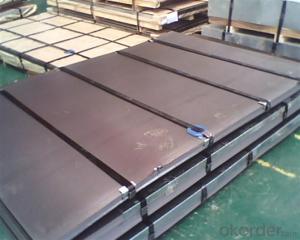COLD ROLLED STEEL COIL-SPCE
- Loading Port:
- China Main Port
- Payment Terms:
- TT OR LC
- Min Order Qty:
- -
- Supply Capability:
- -
OKorder Service Pledge
OKorder Financial Service
You Might Also Like
SPCE COLD ROLLED STEEL
Cold Rolled Steel is steel that has been worked below itsrecrystallization temperature by passing it between a pair of rollers.Recrystallization temperature is the temperature at which grains in the latticestructure of the metal have been rearranged, leaving it free of strain anddeformations. Cold Rolled Steel is pre-treated before being cold rolled with aprocess known as pickling, which uses strong acids to remove scale and otherimpurities. The Cold Rolled Steel is then passed through rollers to reduce itsthickness. Most cold rolling takes place in multiple passes and as the size ofthe Cold Rolled Steel is further reduced, its strength and hardness bothincrease, but its ductility decreases. After cold rolling, heating the metal upin a process known as annealing can restore some of its ductility. The finalCold Rolled Steel may be manufactured in the form of sheets, strips, bars, orother forms.
Application
It’s widely used in outdoor and interior decoration, furnishingmanufacturing, home appliance, automobile etc.
Main Specification
COLD ROLLED STEEL | |
THICKNESS | 0.3-2MM |
WIDTH | 600-1500MM |
SHEET LENGTH | 0-6000MM |
COIL ID | 508MM OR 610MM |
SURFACE TREATMENT | MATT FINISH/BRIGHT FINISH, OILED/DRY |
ANNEALING METHODS | BRIGHT ANNEAL/BLACK ANNEAL |
COIL WEIGHT | 1-25MT |
Package & Delivery
Package details: Standard seaworthy packing for internationaldelivery.
Delivery: According to the exact quantity of your order.
Advantage
1. High Quality Surface Finish
2. High Dimensional Precision
3. Excellent mechanical property
- Q: I recently got in a car accident with a steel mailbox, on a snowy day. I was wondering if i can do anything since the steel mailbox caused my car to be totaled. Otherwise it would have been fine and would have suffered only minor damage. Anything I can do here to maybe get some money back? Thanks!
- That's exactly what happened last winter where I worked. The driver's insurance (it was a late model SUV) paid for the damage to the vehicle and to our mailbox. The 4 inch steel post really bent the SUV.
- Q: i found a similar question asking what metals were in stainless steel but i don't know if they are the same.... they probably aren't.
- steel is iron with a little bit of carbon mixed in. how much carbon determines the hardness of the steel. stainless steel is the same mostly, it has nickle and chromium added in to make it corrosion resistant.
- Q: If rail ties were melted, would they be like any other type of steel?
- As so much about the railroad is variable, so is the steel used for the rail. For one thing, all rail is not the same size. It is classified by weight per yard. For example, most tangent (straight) track is 139 lbs rail, meaning three feet of it weighs this much. Secondary track, such as found on branch lines and in yards or used on sidings is not as heavy. Track used in curvature may be the same weight, but not always. The reason is there is much more stress imparted to the roadbed in curvature. Most steel on main tracks has a higher carbon content, but there is a point of diminishing returns, as this rail is more brittle as a result. Good luck trying to melt it. In the field, this rail is cut by a saw with diamond studded circular blades. The reason why is it takes a lot more time to try to cut it with an acetylene torch. In the US, certain areas, such as on some bridges, the cross-ties (sleepers) are indeed made of steel, in addition to concrete and wood. The potential for fire is too great for wood in these instances. In addition, if even a single wheel derails, concrete ties tend to explode when stressed this way. All of which makes steel cross-ties worth the extra cost.
- Q: If you were selecting a tool steel for an extreme impact load application, which one would you pick? why?thanks
- It all depends what the application actually is. For hammers I would select a hammer grade B1 steel. For impact loading where an edge is needed I would be going for O1 or similar (oil quenching steels tend to be a little tougher than air hardening). For mining tools a very high manganese steel (Hadfields steel) - this is not a true tool steel. The best place to start is by looking at the ranking of the properties which you want - hardness v toughness v strength - and then use this to put the steels in rank order. Price and availablity then sort the problem out for you (in the real world).
- Q: What are the different types of steel coils?
- There are several different types of steel coils, including hot rolled coils, cold rolled coils, galvanized coils, and stainless steel coils.
- Q: What are the different packaging options for steel coils?
- The different packaging options for steel coils include wooden pallets, steel cradles, eye-to-sky or eye-to-wall packaging, and steel banding or strapping. These options are used to ensure the safe transportation and storage of steel coils, preventing damage and maintaining their shape and quality.
- Q: Hi there! I just purchased two cookie sheets labeled as non-stick 100% carbon steel. I've never heard of carbon steel before, and I'm trying to be careful about not using certain products that are harmful to health such as aluminum and Teflon. Is this a safe metal choice for baking?
- Yes. Carbon steel is one of the most common metals used by human beings. When the Bronze Age ended and the Iron Age started, most of the iron humans could make was carbon steel. A Cast Iron frying pan is carbon steel (well... technically, there are differences between cast irons and steels but... anyway). Our cast iron frying pans (almost the only fry pans we have used for 30+ years) are mostly non-stick because we keep them well seasoned. Humans need iron in our diet anyway. You might want to check to verify what (if anything) it is coated with to make it Non-stick because, in general, steel cookware is stick. If it is coated with ceramic (enameled), then there won't be any rust because the iron is coated and protected from water. The non-stick ceramic coatings are very good. Ceramics are chemically inert to almost everything on earth (all but some of the most exotic chemicals you will ever find in a Chem Lab). As a side note... a large number of studies of industrial exposure to aluminum and aluminum compounds (people who work in Al production plants and are exposed to large quantities for years and years and years) has shown that there is NO correlation with Alzheimers or any other diseases. The major health risk for these populations was lung problems due to inhalation of fine dust (which, turned out, was not even as bad as breathing, for example, dust containing cotton fibers in garment workers).
- Q: like, what can steel make?
- buildings bridges automobiles elevators railroads and railroad equipment appliances and many many more. Steel is used almost everywhere. reference: Iron and steel are used widely in the construction of roads, railways, infrastructure, and buildings. Most large modern structures, such as stadiums and skyscrapers, bridges, and airports, are supported by a steel skeleton. Even those with a concrete structure will employ steel for reinforcing. In addition to widespread use in major appliances and cars (Despite growth in usage of aluminium, it is still the main material for car bodies.), steel is used in a variety of other construction-related applications, such as bolts, nails, and screws.[66] Other common applications include shipbuilding, pipeline transport, mining, offshore construction, pipeline transport, aerospace, white goods (e.g. washing machines), heavy equipment (e.g. bulldozers), office furniture, steel wool, tools, and armour in the form of personal vests or vehicle armour (better known as rolled homogeneous armour in this role). .
- Q: How are steel coils protected from condensation?
- Steel coils are protected from condensation by applying a layer of corrosion-resistant coating, such as zinc or a polymer, on the surface. This coating acts as a barrier, preventing moisture from coming into direct contact with the steel and reducing the chances of condensation occurring. Additionally, steel coils are often stored in controlled environments with controlled humidity levels to further minimize the potential for condensation.
- Q: What are the disadvantages of using steel coils?
- One disadvantage of using steel coils is their weight and size, which can make transportation and handling challenging. Additionally, steel coils are susceptible to corrosion, requiring regular maintenance and protective measures to prevent rusting. The production of steel coils also contributes to environmental pollution due to the energy-intensive manufacturing process. Lastly, the upfront cost of steel coils can be relatively high compared to other materials, which may not be suitable for budget-constrained projects.
Send your message to us
COLD ROLLED STEEL COIL-SPCE
- Loading Port:
- China Main Port
- Payment Terms:
- TT OR LC
- Min Order Qty:
- -
- Supply Capability:
- -
OKorder Service Pledge
OKorder Financial Service
Similar products
Hot products
Hot Searches
Related keywords
